Parkinson’s Disease Robert L. Copeland, Ph. D. Howard


Parkinson's Disease Robert L. Copeland, Ph.D. Howard University College of Medicine Department of Pharmacology 18 February 2002

Parkinson Disease Neurological disease affecting over four million patients worldwide, over 1.5 million people in the U.S.. While it can affect individuals at any age, it is most common in the elderly. The average age of onset is 55 years, although approximately 10 percent of cases affect those under age 40.

Parkinson's disease was first formally described in "An Essay on the Shaking Palsy," published in 1817 by a London physician named James Parkinson, but it has probably existed for many thousands of years. Its symptoms and potential therapies were mentioned in the Ayurveda, the system of medicine practiced in India as early as 5000 BC, and in the first Chinese medical text, Nei Jing, which appeared 2500 years ago.

Appears Later in Life Continuous Progressive Neurological Disease, thereby causing increasing disability of movement no cure

Etiology Cerebral atherosclerosis Viral encephalitis Side effects of several antipsychotic drugs (i.e., phenothiazides, butyrophenones, reserpine)

Environmental factors and neurotoxins Pesticides, herbicides, industrial chemicals - contain substances that inhibit complex I in the mitochondria


In Terms of Etiology and Clinical Picture, Major Symptoms Involve: Bradykinesia- Slowness in Initiation and Execution of Voluntary Movements Rigidity - Increase Muscle Tone and Increase Resistance to Movement (Arms and Legs Stiff) Tremor - Usually Tremor at Rest, When Person Sits, Arm Shakes, Tremor Stops When Person Attempts to Grab Something Postural Instability - abnormal fixation of posture (stoop when standing), equilibrium, and righting reflex Gait Disturbance - Shuffling Feet

Usually Other Accompanied Autonomic Deficits Seen Later in Disease Process: Orthostatic Hypotension Dementia Dystonia Ophthalmoplegia Affective Disorders

Parkinson Disease Neurochemistry Loss of Dopaminergic (DA) Cells Located in Basal Ganglia; most symptoms do not appear until striata DA levels decline by at least 70-80%.

Imbalance primarily between the excitatory neurotransmitter Acetylcholine and inhibitory neurotransmitter Dopamine in the Basal Ganglia ACh DA

The Dopaminergic Neurons in the Basal Ganglia Are mainly affected Acetylcholine within striatum is a tonically activated neuron It impinges on GABA Neuron by an Excitatory Action GABA Neuron Has an Inhibitory Action on the Substantia Nigra from Substantia Nigra, Has a Dopaminergic Feed Back Loop Back to Striatum Which Gets Loss Giving Signs and Symptoms of Parkinson Disease

Basal Ganglia The Basal Ganglia Consists of Five Large Subcortical Nuclei That Participate in Control of Movement: Caudate Nucleus Putamen Globus Pallidus Subthalamic Nucleus Substantia Nigra
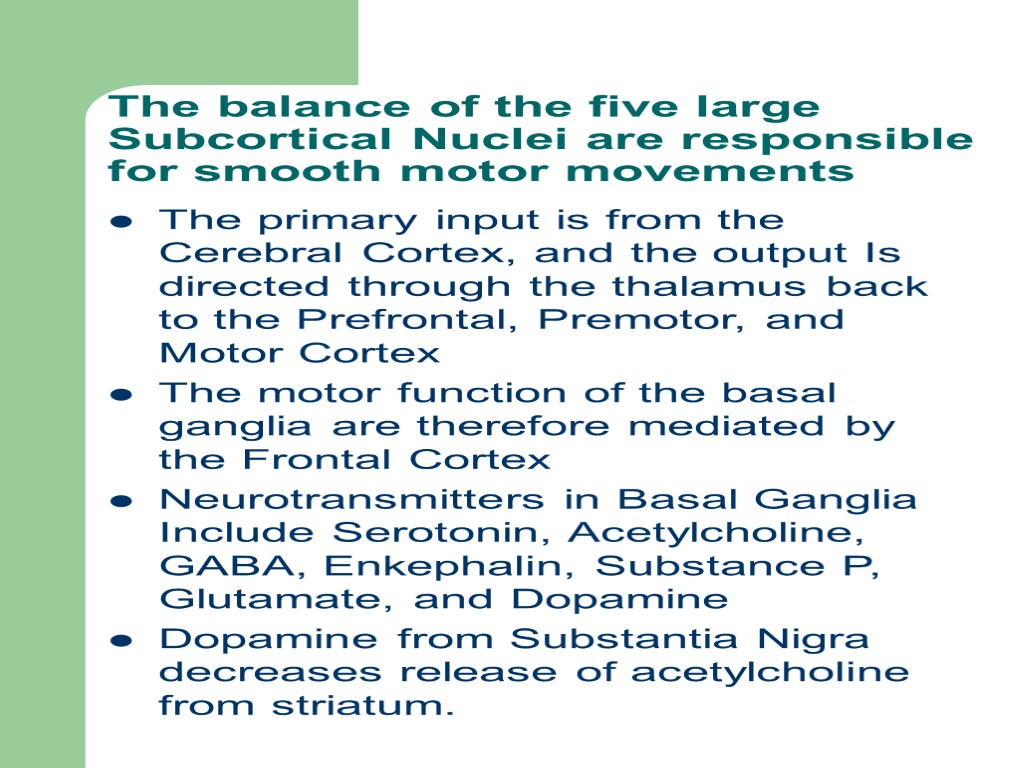
The balance of the five large Subcortical Nuclei are responsible for smooth motor movements The primary input is from the Cerebral Cortex, and the output Is directed through the thalamus back to the Prefrontal, Premotor, and Motor Cortex The motor function of the basal ganglia are therefore mediated by the Frontal Cortex Neurotransmitters in Basal Ganglia Include Serotonin, Acetylcholine, GABA, Enkephalin, Substance P, Glutamate, and Dopamine Dopamine from Substantia Nigra decreases release of acetylcholine from striatum.

Drug Therapy Drug Therapy Against Parkinson Disease Is Aimed at Bringing the Basal Ganglia Back to Balance Decrease Cholinergic Activity Within Basal Ganglia and this Can Be Done Two Ways: Activating Dopamine receptors in Substantia Nigra feeding back to Cholinergic Cells in the striatum Turn off the Cholinergic Cells, Then Things Are Brought Back to Balance Antagonize Acetylcholine receptors
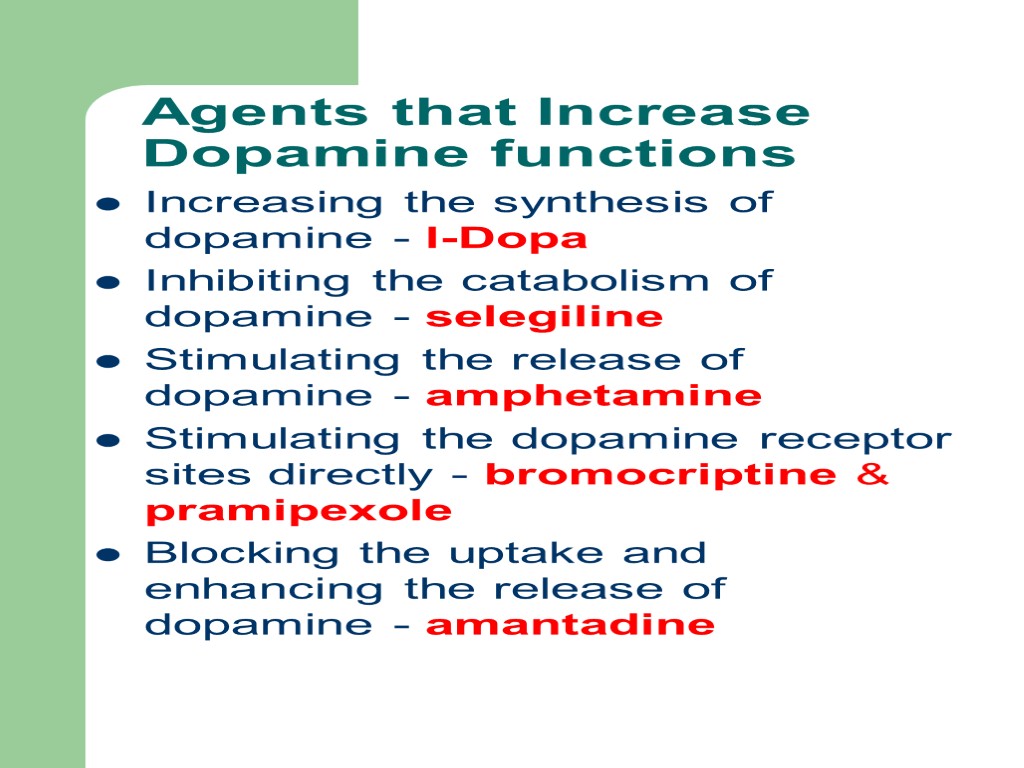
Agents that Increase Dopamine functions Increasing the synthesis of dopamine - l-Dopa Inhibiting the catabolism of dopamine - selegiline Stimulating the release of dopamine - amphetamine Stimulating the dopamine receptor sites directly - bromocriptine & pramipexole Blocking the uptake and enhancing the release of dopamine - amantadine

Dopamine and Tyrosine Are Not Used for Parkinson Disease Therapy Dopamine Doesn't Cross the Blood Brain Barrier Huge amount of tyrosine decreases activity of rate limiting enzyme Tyrosine Hydroxylase That normally Converts Tyrosine to dopamine by overwhelming enzyme tyrosine hydroxylase, has a feedback loop that will turn off tyrosine hydroxylase

L Dopa Therapy for Parkinson Disease Dopamine Decarboxylase Converts L Dopa to Dopamine That Gets Stored into Secretory Vesicles and Gets Released from Basal Ganglia


L Dopa- Pharmacokinetics L Dopa is readily absorbed from GI Tract Usually large doses must be given since ~1% actually cross Blood Brain Barrier enters CNS Large amount of L Dopa has to be given due to First Pass Effect L Dopa metabolized by dopa decarboxylase in liver and periphery to dopamine Secreted in urine unchanged or conjugated with glucoronyl sulfate Most of L Dopa converted in periphery to NE and EPI

Effects of L Dopa on the Symptoms of Parkinson Disease L Dopa Fairly Effective in Eliminating Most of the Symptoms of Parkinson Disease Bradykinesia and Rigidity Quickly Respond to L Dopa Reduction in Tremor Effect with Continued Therapy L Dopa less Effective in Eliminating Postural Instability and Shuffling Gait Meaning Other Neurotransmitters Are Involved in Parkinson Disease

Effects of L Dopa on Behavior In Terms of Behavior, L Dopa Partially Changes Mood by Elevating Mood, and L Dopa Increases Patient Sense of Well Being Significant Number of Patients Get Behavior Side Effects

Effects of L Dopa on Cardiovascular System The Cardiovascular Effects Are Cardiac Stimulation Due to Beta Adrenergic Effect on Heart Treat with Propranolol to Block Cardiac Stimulation Effects Must be careful in treatment of elderly, most will have underlying cardiovascular problems, can transient tachycardia, cardiac arrhythmias and hypertension In Some Individuals, L Dopa produces Orthostatic Hypotension Tolerance Will Develop Within Few Weeks

Effects of L Dopa on Gastrointestinal System Very Common Gastrointestinal Effects of L Dopa Include Nausea, Vomiting, and Anorexia Probably Due to Stimulation of Chemoreceptor Trigger Zone (CTZ) in Medulla Tolerance Develops in a Few Weeks to this Effect Other GI Disturbances Are Abdominal Pain

GI cont. Some Patients Have Diarrhea and Some Patients Have Constipation May cause activation of Peptic Ulcer Control Abdominal Effect by Giving Drug in Low Doses and gradually increase dose. Give Drug with some food so as to have something in Stomach
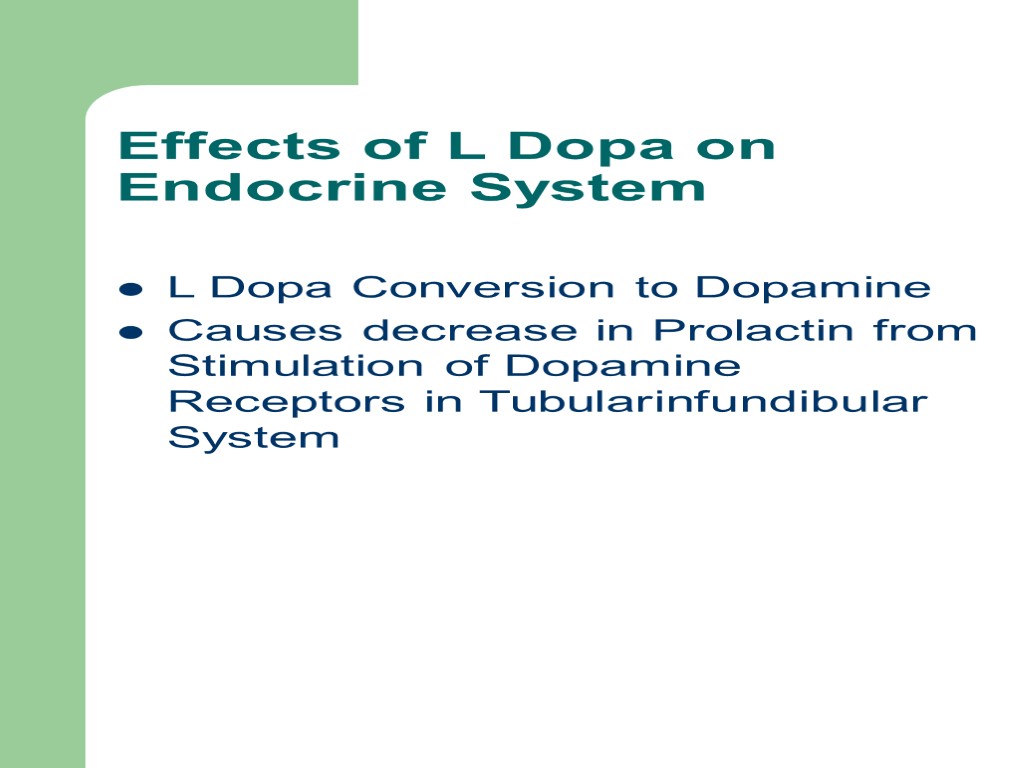
Effects of L Dopa on Endocrine System L Dopa Conversion to Dopamine Causes decrease in Prolactin from Stimulation of Dopamine Receptors in Tubularinfundibular System
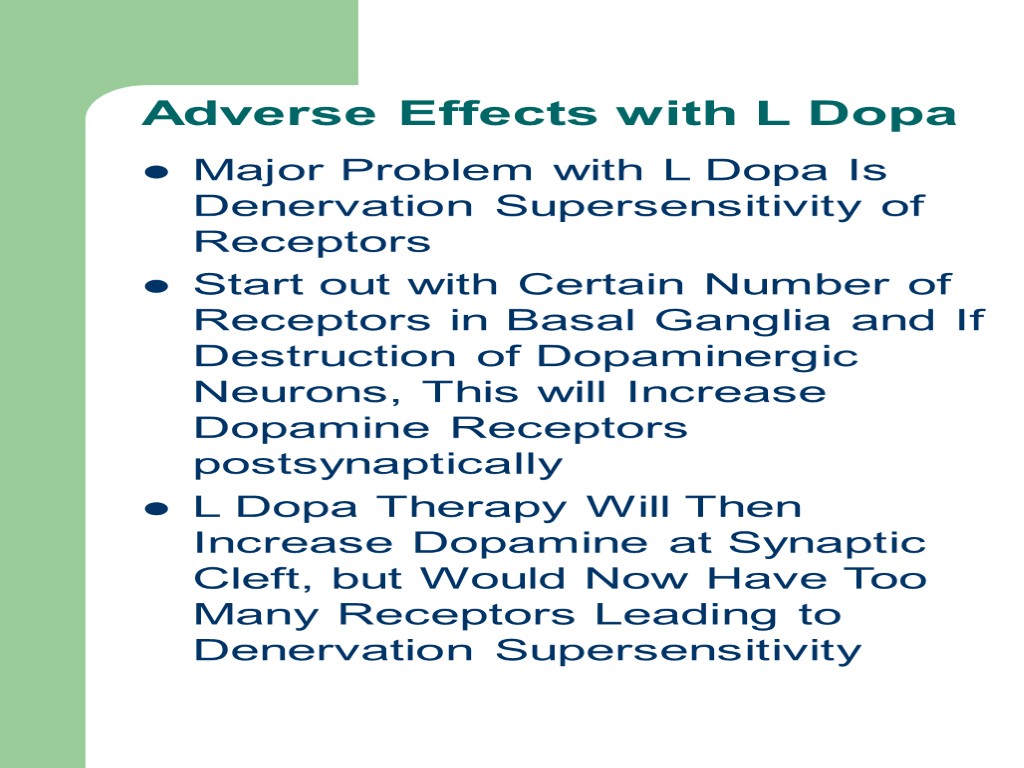
Adverse Effects with L Dopa Major Problem with L Dopa Is Denervation Supersensitivity of Receptors Start out with Certain Number of Receptors in Basal Ganglia and If Destruction of Dopaminergic Neurons, This will Increase Dopamine Receptors postsynaptically L Dopa Therapy Will Then Increase Dopamine at Synaptic Cleft, but Would Now Have Too Many Receptors Leading to Denervation Supersensitivity

Denervation Supersensitivity Effect Is Increased Postsynaptic Transmission Initial Disappearance of Parkinson Syndrome Onset of Tardive Dyskinesia

Adverse Effects of L Dopa Some are Irreversible and Dose Dependent However, Long Term Therapy with L Dopa Not Associated with Renal or Liver Effects Early in Therapy, 80% of Patients Have Nausea and Vomiting Due to Chemoreceptor Trigger Zone Stimulation 30% of Patients have Orthostatic Hypotension; So must Carefully Regulate Dose

Adverse effects cont. See Cardiac Arrhythmia from Stimulation of Adrenergic Receptors in Heart (Autonomic lecture). Adjust Dose for People with Cardiac Problems 50% of Patients Have Abnormal Involuntary Movements; ie. grimacing of face and tongue movements; slow writhing type of movements (Not Jerky Movements) in Arm and Face This Is Due to High Dose of Dopa and Occurs Early in Therapy at 2 to 4 Weeks Best Way to Handle Is by Reducing Dose

Long Term Therapy Behavioral Disturbances in 20 to 25% of Population Trouble in Thinking (Cognitive Effects) L Dopa Can Induce: Psychosis Confusion Hallucination Anxiety Delusion Some Individuals develop Hypomania Which Is Inappropriate Sexual Behavior; "Dirty Old Man", "Flashers"

Treatment Treatment Is to reduce Dose and Put Person on Drug Holiday Where Stop All Medication for 3-21 Days and Then Slowly Reinitiate Therapy to Gradually increasing doses.

"On/off" Effect "On/off" Effect Is like a Light Switch ; Without Warning, All of a Sudden, Person Goes from Full Control to Complete Reversion Back to Bradykinesia, Tremor, Etc. Lasting from 30 Minutes to Several Hours and Then Get Control Again "On/off" Effect Occurs after usually after 2 or more years on L Dopa Related to Denervation Hypersensitivity

Treat by Giving Small Dose Regiments from 16 to 20 Hours "On/off" Effect May Be Due to Composite of Amino Acids That Use Same Dopamine Transportor across Gastric Mucosa causing extremely low levels of L Dopa in CNS thereby causing symptoms of Parkinson Disease to reappear. Changing diet (to low protein), may cause large conc of L Dopa in CNS Giving thus producing an 'off' Effect of Symptoms of Parkinson Disease

Drug Interactions with L Dopa Vitamin B6 - Vitamin B6 Is a Cofactor for Decarboxylation of L Dopa; Vitamin B6 Enhances Conversion of L Dopa to Dopamine in Periphery Making it less Readily for Use in the CNS L Dopa Is co-administered with Carbidopa

Drug Interactions cont Carbidopa Is Antagonistic to Peripheral L Dopa Decarboxylation Carbidopa Doesn't Cross Blood Brain Barrier By co-administering Carbidopa, will decrease metabolism of L Dopa in GI Tract and Peripheral Tissues thereby increasing L Dopa conc into CNS; meaning we can decrease L Dopa dose and also control the dose of L Dopa to a greater degree.

Drug Interactions cont Antipsychotic Drugs - Antipsychotic Drugs Block Dopamine Receptor Reserpine -Reserpine Depletes Dopamine Storage Anticholinergics - Used Synergistically with L Dopa as an Antiparkinson Agent, but Anticholinergics Act to decrease L Dopa absorption since Anticholinergics have an effect on gastric emptying time which delays crossing of GI Membrane by L Dopa

Drug Interactions cont Nonspecific MAO Inhibitors - Interfere with L Dopa Breakdown and exaggerate the CNS effects the Nonspecific MAO Inhibitors Can Precipitate Hypertensive Crisis by the tyramine-cheese effect (Tyramine Is Found in Cheese, Coffee, Beer, Pickles, Chocolate, and Herring), when given to a person taking a MAO Inhibitor Tyramine Is not broken down therefore producing a tremendous release of Norepinephrine)

Other Drugs for Treating Parkinson Disease Before Using Other Drugs, First Use L Dopa until Dosage of L Dopa Starts Becoming too high for the Patient; L Dopa's Therapeutic and Toxicity Index Figures become too close

Bromocriptine for Treating Parkinson Disease ; an Ergotamine derivative, acts as a Dopamine Receptor Agonist the Drug Produces Little Response in Patients That Do Not React to Levodopa

Pramipexole is a nonergot dopamine agonist with high relative in vitro specificity and full intrinsic activity at the D2 subfamily of dopamine receptors, binding with higher affinity to D3 than to D2 or D4 receptor subtypes. precise mechanism of action is unknown, although it is believed to be related to its ability to stimulate dopamine receptors in the striatum.

Amantadine for Treating Parkinson Disease Amantadine Effective as in the Treatment of Influenza, however has significant Antiparkinson Action; it appears to Enhance Synthesis, Release, or Reuptake of Dopamine from the Surviving Nigral Neurons
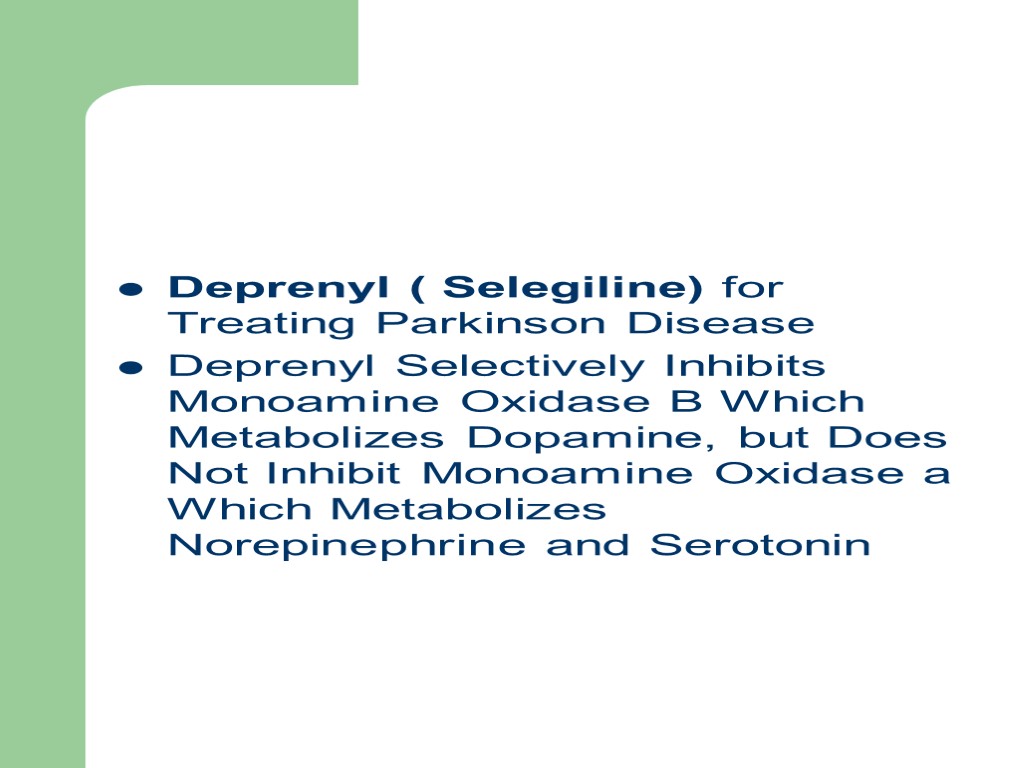
Deprenyl ( Selegiline) for Treating Parkinson Disease Deprenyl Selectively Inhibits Monoamine Oxidase B Which Metabolizes Dopamine, but Does Not Inhibit Monoamine Oxidase a Which Metabolizes Norepinephrine and Serotonin

The Protective Effects of Selegiline Although the factors responsible for the loss of nigrostriatal dopaminergic neurons in Parkinson's disease are not understood, the findings from neurochemical studies have suggested that the surviving striatal dopamine neurons accelerate the synthesis of dopamine, thus enhancing the formation of H202 according to the following scheme.

Monoamine oxidase B Dopamine + 02 + H20----------> H202 + NH3 + 3,4 dihydroxyphenylacetaldehyde Glutathione peroxidase H202 + 2 G S H ----------> G S S G + 2 H20
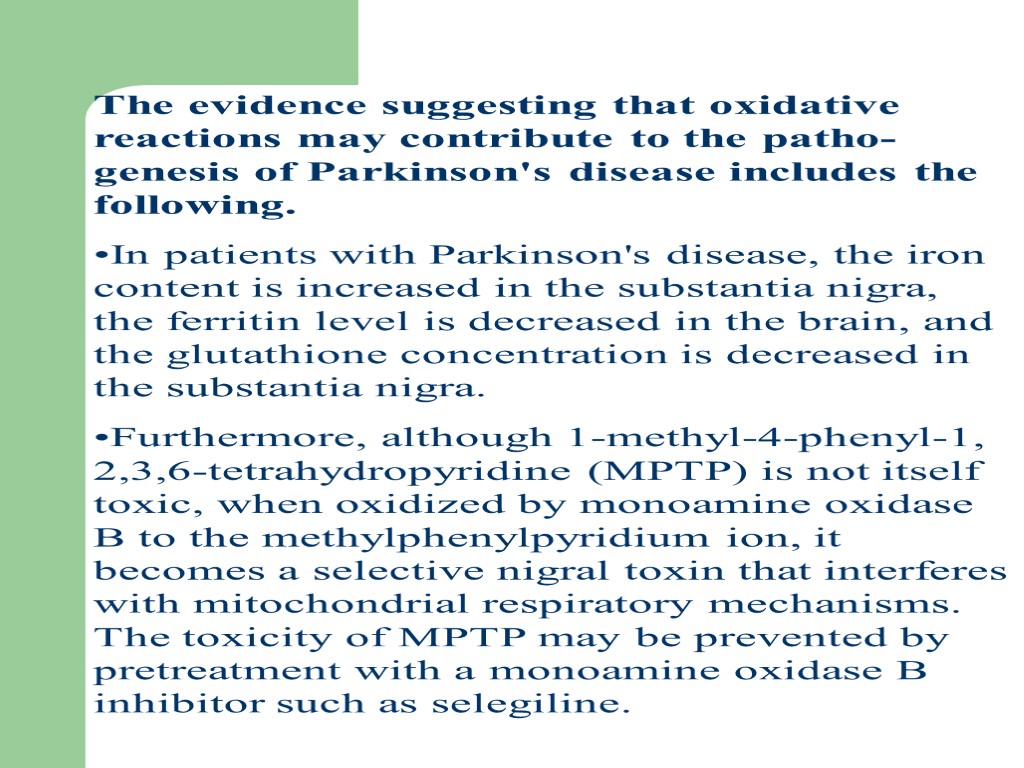
The evidence suggesting that oxidative reactions may contribute to the patho-genesis of Parkinson's disease includes the following. In patients with Parkinson's disease, the iron content is increased in the substantia nigra, the ferritin level is decreased in the brain, and the glutathione concentration is decreased in the substantia nigra. Furthermore, although 1-methyl-4-phenyl-1, 2,3,6-tetrahydropyridine (MPTP) is not itself toxic, when oxidized by monoamine oxidase B to the methylphenylpyridium ion, it becomes a selective nigral toxin that interferes with mitochondrial respiratory mechanisms. The toxicity of MPTP may be prevented by pretreatment with a monoamine oxidase B inhibitor such as selegiline.

Amphetamine for Treating Parkinson Disease Amphetamine Has Been Used Adjunctively in the Treatment of Some Parkinsonian Patients it Is Thought That, by Releasing Dopamine and Norepinephrine from Storage Granules, Amphetamine Makes Patients More Mobile and More Motivated

Catechol-O-methyltransferase (COMT) inhibitors Tolcapone (Tasmar) and Entacapone (Comtan) are two well-studied COMT inhibitors. Increases the duration of effect of levodopa dose Can increase peak levels of levodopa Should be taken with carbidopa/levodopa (not effective used alone) Can be most beneficial in treating "wearing off" responses Can reduce carbidopa/levodopa dose by 20-30%

Antimuscarinic Agents for Treating Parkinson Disease The Antimuscarinic Agents Are Much less Efficacious than Levodopa, and These Drugs Play Only an Adjuvant Role in Antiparkinson Therapy the Actions of Atropine, Scopolamine, Benztropine, Trihexyphenidyl, and Biperiden Are Similar

On the Horizon A number of potential Parkinson's treatments in research laboratories now show much promise. They include: Neurotrophic proteins--These appear to protect nerve cells from the premature death that prompts Parkinson's. One hurdle is getting the proteins past the blood-brain barrier. Neuroprotective agents--Researchers are examining naturally occurring enzymes that appear to deactivate "free radicals," chemicals some scientists think may be linked to the damage done to nerve cells in Parkinson's and other neurological disorders.


Risk of Parkinsonism in smokers is 20-70% less than non-smokers; nicotine may increase firing rate of dopaminergic neurons
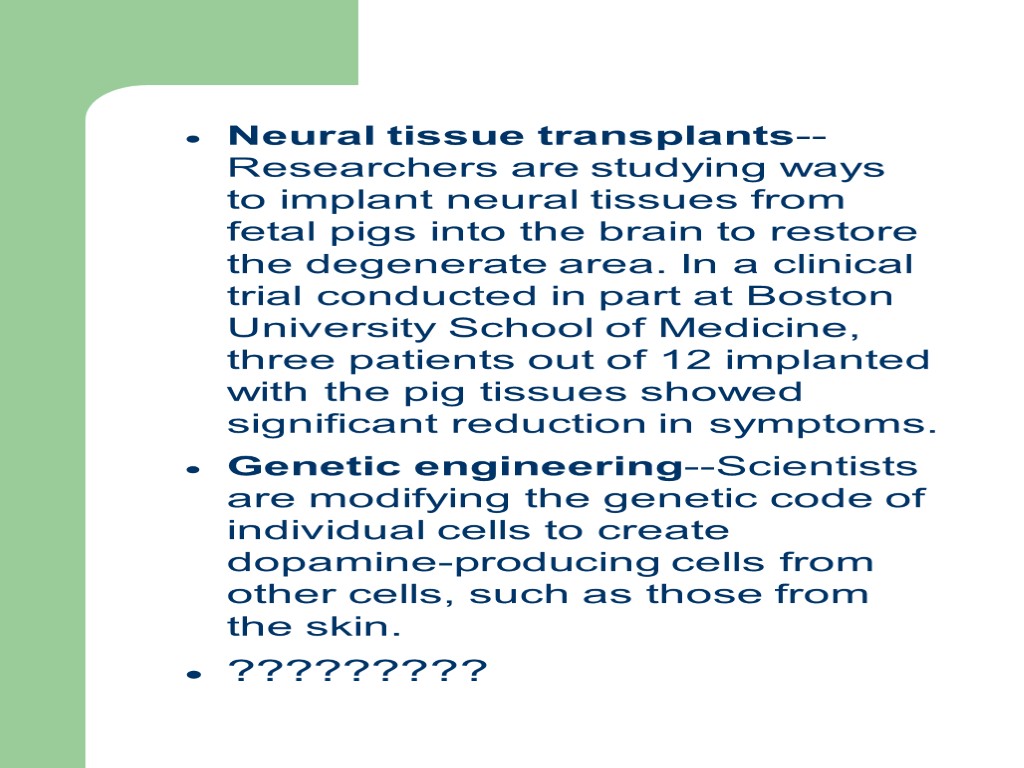
Neural tissue transplants--Researchers are studying ways to implant neural tissues from fetal pigs into the brain to restore the degenerate area. In a clinical trial conducted in part at Boston University School of Medicine, three patients out of 12 implanted with the pig tissues showed significant reduction in symptoms. Genetic engineering--Scientists are modifying the genetic code of individual cells to create dopamine-producing cells from other cells, such as those from the skin. ?????????
parkinson's_disease_ii.ppt
- Количество слайдов: 53

